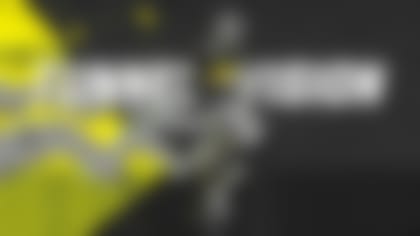After decades of despair, a historically dominant linebacker corps changed everything for the New Orleans Saints.
By Alex Gelhar | Published Oct. 26, 2016
Illustration by Mary Jane Kim
Deep in the fourth quarter of a late-November showdown with the Steelers at Three Rivers Stadium, the Saints' defense has its back to the end zone, trying to protect a 20-14 lead as Pittsburgh faces a first-and-goal from the 4-yard line.
The Saints are riding a four-game winning streak, but the stakes are higher than simply pushing that run to five straight. A victory for New Orleans clinches a winning record for the 1987 season -- a feat that has yet to be accomplished in the franchise's 20-year history.
The home crowd's deafening roar descends upon the field, attempting to will the Steelers into the end zone.
Two straight runs at the heart of New Orleans' vaunted front seven net Pittsburgh just 3 yards, with key tackles by middle linebacker Vaughan Johnson and Pro Bowl outside linebacker Rickey Jackson. Precious seconds erode from the game clock.
"Like throwing popcorn at a battle ship, trying to run inside like that," former Chiefs head coach Hank Stram quips alongside Tim Brant from the CBS Sports booth. He's been barking for the Steelers to try something to the outside. And on third-and-goal, Stram gets his wish.
Fullback Frank Pollard leaks out into the flat as middle linebacker Sam Mills is uncharacteristically late to diagnose the play. With Steelers quarterback Mark Malone rolling to his right, Pollard is wide open. The go-ahead score seems imminent ... until Jackson blows past pulling guard Terry Long and bats Malone's pass harmlessly to the ground.
Fourth-and-goal. Fourth-and-game. Call it what you will -- at this point, there hasn't been a more important down and distance in Saints history.
The play call is a power toss to the left. Pollard sprints for the goal line, but right outside linebacker Pat Swilling sets the edge well enough to turn him upfield sooner than he'd like. Instead of running to daylight, Pollard is met by a 5-foot-9 brick wall better known as Samuel Davis Mills Jr.
Turnover on downs.
"Look at the shot inside!" Stram exclaims, watching a replay of Mills' hit. "I don't care who it was -- it was a great performance on the part of the New Orleans Saints."
The players erupt in celebration, tasting that elusive winning season. And even though the defense later would have to seal the win by intercepting Malone for the third time, the goal-line stand is why this game is remembered. Not only did it bring the Saints their first campaign north of .500 in 20 years -- the longest drought in 撸先生AV history -- it was made with key plays by linebackers Rickey Jackson, Sam Mills, Vaughan Johnson and Pat Swilling.
Together they formed the most dominant linebacking corps the league has ever seen. Over the course of their six seasons starting together, they'd go on to set numerous records, earn a combined 13 trips to the Pro Bowl and march the Saints to the playoffs four separate times while leading a defense that was feared across the league. And as the franchise celebrates its 50th anniversary, their indelible impact demands to be reexamined.
They were the Dome Patrol.















